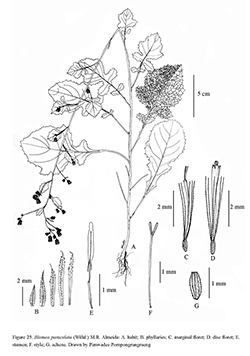e-Flora of Thailand
Volume 13 > Part 2 > Year 2016 > Page 222 > Compositae (Asteraceae) > Blumea
17. Blumea paniculata (Willd.) M.R.Almeidawfo-0000089606
Flora of Maharashtra 3: 84. 2001.— Conyza paniculata Willd., Sp. Pl. 3: 1920. 1797. Fig. 25.
Accepted Name : Pluchea paniculata (Willd.) Karthik. & Moorthy
Fl. Pl. India: 259. 2009.
Synonyms & Citations :
Description : Annual herb, 0.1–1 m tall; stems erect, pubescent with glandular hairs. Leaves petiolate, blade ovate, oblanceolate or distinctly lyrately lobed with elliptic-ovate terminal lobe and more-or-less triangular lateral lobes, 4–38 by 1.5–15 cm, apex acute or obtuse, base attenuate or cuneate, margins lyrate or dentate, thinly papyraceous, bright green, upper surface pubescent, upper leaves and inflorescence bracts smaller, broadly ovate, undivided; petioles 0.5–5 cm long. Inflorescences terminal, large, loose panicles, 5–20 cm long. Capitula 4–5 mm diam., peduncles 5–25 mm long with pilose hairs; involucres campanulate; phyllaries 5 (–6)-seriate, outer linear, densely pilose with stipitate glands, inner linear with scarious margins, with scattered stipitate glands; receptacle 1–1.5 mm diam., flat or slightly convex, alveolate, glabrous. Marginal floret corollas yellow, basal tube 3–5 mm long, corolla lobes generally glabrous. Disc floret corollas yellow, basal tube 3.5–5.5 mm long, glabrous, lobes oblong-lanceolate, ca 0.2 mm long, pubescent with unicellular and glandular hairs; anthers 0.5–0.7 mm long, apical appendages emarginate, bases with unbranched tails, anther-tails shorter than anther collars; style arms 0.5–0.7 mm long, base cylindrical. Achenes oblong, 10-ribbed, 0.6–0.8 mm long, setuliferous; pappus bristles 10–13, 2.8–5 mm long, caducous, white.
Thailand : NORTHERN: Mae Hong Son (Pai, Huai Yuak, Mo Paeng Falls), Chiang Mai (Ban Mae Kon, Doi Suthep, Fang Hot Spring Park, Mae Sa, Fang, Doi Chiang Dao, Doi Suthep), Chiang Rai (Ban Yang Kham Nu), Lampang (Ban Mae Thak to Hang Chat, Huai Mae San); NORTH-EASTERN: Phetchabun (Nam Nao NP), Loei (Phu Luang, Phu Kradueng), Nakhon Phanom (Phu Mu Forest Park), Muk Dahan (Kham Cha-i), Khon Kaen (Nong Waeng, Phaphang Forest Park); SOUTH-WESTERN: Uthai Thani (Huai Kha Khaeng WS), Kanchanaburi (Sai Yok Noi, Sai Yok Yai, Erawan NP, Wangka); CENTRAL: Ang Thong, Saraburi (Sam Lan); SOUTH-EASTERN: Prachin Buri, Chon Buri (Chundaten Falls, Khao Yai NP), Chanthaburi (Khitchakut NP, Khlong Narai Falls); PENINSULAR: Ranong (Khao Phota Luang Kaeo), Phangnga (Ko Talibong), Trang (Khao Chong), Songkhla (Boriphat Falls).
Distribution : China (Hainan, Guangdong, Yunnan, Taiwan), India, Bhutan, Nepal, Pakistan, Sri Lanka, Myanmar, Laos, Vietnam, Malaysia (Peninsular), Indonesia (Kalimantan, Java), New Caledonia.
Ecology : Cultivated fields, on humus slopes in deciduous forests or along rocky shores, dry evergreen forests, usually near streams, to 1,500 m alt. Flowering: November–April.
Vernacular : Sa-mo-pho (สะโมะโพ่)(Karen-Kanchanaburi); nat din (หนาดดิน)(Satun).

